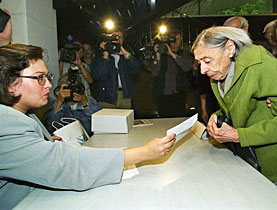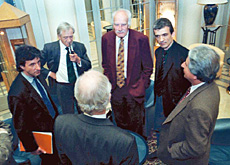Vote for Hitler “normal” in economic context

Long viewed as a historical aberration, Adolf Hitler's rise to power can partly be put down to "normal voting behaviour", a Zurich University study has shown.
But researchers demonstrate that the voters most hurt by the depression, and most likely to oppose the government, were a disparate group who did not uniformly turn to the Nazis.
“The consequences of Hitler’s election were extraordinary,” the authors say, “but the voting behaviour that led to it was not.”
Because of the unprecedented circumstances in which free and fair democratic elections led to the antidemocratic National Socialist Party winning control of the Weimar Republic, the question of who voted for Hitler has become the most studied in the history of voting behaviour research.
The latest study, a Swiss-US collaboration between a social scientist, statistician, mathematician and economist, sets out to discover who had an interest, specifically an economic interest, in voting for Hitler.
There is a vast existing body of literature on why the German people – eventually 38.7 per cent of the electorate in 1933 – voted for the Austrian.
Not unique
Professor Alexander Wagner of Zurich University’s Swiss Banking Institute said the research team decided not to treat the elections between 1924 and 1932 as unique, in contrast to previous academic literature.
“We began with the notion that these were elections like any other. So we started with an economic explanation. We looked at all the elections and all the parties together in a statistical way,” he told swissinfo.
In more than 70 years of research almost every social group has been blamed for having backed Hitler at the ballot box, and indeed support for the party was spread across the social spectrum.
However this study, published in the Journal of Economic History, identifies a set of people – “the working poor” – who stood to benefit most from Nazi policies. It also confirms that they voted proportionally more for the Nazis.
The group includes the self-employed, typically small shopkeepers, farmers and artisans, farm labourers and domestic servants, but excludes the unemployed and factory workers.
Rural labourers, domestic servants and family members helping relatives are significant groups that have been completely overlooked by previous literature, according to Wagner and his colleagues.
“We have the best data on that group and were able to look at their behaviour,” he said.
Hard times
Unlike industrial workers, these rural and domestic workers had no social security net in the form of unemployment insurance. Likewise, small shopkeepers did not officially become unemployed – they just made less money.
Therefore these groups did not have any stake in the government’s unemployment policies and were more drawn to the free enterprise promises of the Nazis.
“That was our hypothesis: that blue-collar workers and the unemployed would regard either the government or the communists, who were for expropriation, as the party to vote for. Indeed, we found support for that.”
This contrasts with findings in previous literature that identify the unemployed in particular as helping the Nazis in their rise to power.
“We find to the contrary that the unemployed voted proportionally less for the National Socialists and proportionally more for the communists,” Wagner said.
The Nazis also performed less strongly in Catholic regions than Protestant regions. “That is perhaps the one result that virtually all scholars agree on, but one can put different interpretations on this.”
Wagner explains that the Catholic Church was an active supporter of the Catholic Zentrum party and the Bayern People’s Party (also Catholic), giving people incentives to support these parties through its social welfare work.
Never again?
Although it is normal for people to vote in their own economic interest, this is not the only driving force at election time.
“Of course I’m not claiming that economic interest is the only thing that matters, but it is one aspect that plays an important role when people go into the polling both,” Wagner said.
But if backing the Nazis fits into voting norms, where does that leave the “never again” question?
“I’m afraid it could happen again. Democracy is the best and worst system in that sense in that powers can arise democratically that are ultimately undemocratic,” Wagner warned.
There are lessons in these findings for European politics today, he adds.
“The National Socialists never had an absolute majority and yet they were able to seize power from the base of popular support they had. What is so interesting about this period is how a fairly small party [three per cent of the vote in 1924] became such a big party and how it was able to use what relatively little power it had gained to essentially ruin the whole system,” he said.
“Quite a few far right parties are reaching ten per cent plus in Europe and I would be very cautious about playing down developments in the rightwing and leftwing extremist spectrum.”
Electoral support for the Nazi party
December 1924: less than 3 per cent
July 1932: 31.1 per cent
November 1932: 26.5 per cent
March 1933: 38.7 per cent
After the extreme hyperinflation of 1922/1923, the years 1924 to 1928 were characterised by an economic boom in Germany.
However, already by 1927/8 indicators were beginning to show the first signs of recession. The German slump began with a gradual slide into depression.
The gross national product (GNP) reached its peak in 1928 and declined in the following years, leading to a loss of more than a quarter of GNP between 1929 and 1932. Unemployment rose and bankruptcy was rampant.
“The dynamics of the Weimar Republic’s electoral swing between 1924 and 1933 to Hitler and the Nazi Party parallel that of almost every other swing in the history of democratic elections.
The national swing to the Nazis fits a standard retrospective voting explanation, explaining a retreat from the established parties and a shift to increasingly extreme opposition parties resulting from the disastrous economic conditions (in addition to ideological shifts towards nationalism and anti-Semitism).
Our results indicate that the majority of social groups swung in the same direction by approximately the same amount.
But … we were also able to identify the groups that moved disproportionately and distinctively compared to the national swing baseline, thus invalidating the notion that the Nazis were a catchall party.”
Authors: Gary King, Ori Rosen, Martin Tanner, and Alexander F. Wagner

In compliance with the JTI standards
More: SWI swissinfo.ch certified by the Journalism Trust Initiative













You can find an overview of ongoing debates with our journalists here . Please join us!
If you want to start a conversation about a topic raised in this article or want to report factual errors, email us at english@swissinfo.ch.